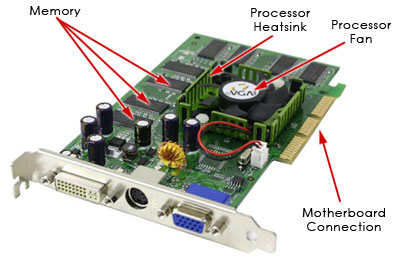
Graphics Card Basics
Think of a computer as a company with its own art department. When people in the company want a piece of artwork, they send a request to the art department. The art department decides how to create the image and then puts it on paper. The end result is that someone's idea becomes an actual, viewable picture.
Think of a computer as a company with its own art department. When people in the company want a piece of artwork, they send a request to the art department. The art department decides how to create the image and then puts it on paper. The end result is that someone's idea becomes an actual, viewable picture.

Photo courtesy of HowStuffWorks Shopper
The four main components of a graphics card are connections for the motherboard and monitor, a processor, and memory.
A graphics card works along the same principles. The CPU, working in conjunction with software applications, sends information about the image to the graphics card. The graphics card decides how to use the pixels on the screen to create the image. It then sends that information to the monitor through a cable.
The Evolution of Graphics CardsGraphics cards have come a long way since IBM introduced the first one in 1981. Called a Monochrome Display Adapter (MDA), the card provided text-only displays of green or white text on a black screen. Now, the minimum standard for new video cards is Video Graphics Array (VGA), which allows 256 colors. With high-performance standards like Quantum Extended Graphics Array (QXGA), video cards can display millions of colors at resolutions of up to 2040 x 1536 pixels.
Creating an image out of binary data is a demanding process. To make a 3-D image, the graphics card first creates a wire frame out of straight lines. Then, it rasterizes the image (fills in the remaining pixels). It also adds lighting, texture and color. For fast-paced games, the computer has to go through this process about sixty times per second. Without a graphics card to perform the necessary calculations, the workload would be too much for the computer to handle. Integrated GraphicsMany motherboards have integrated graphics capabilities and function without a separate graphics card. These motherboards handle 2-D images easily, so they are ideal for productivity and Internet applications. Plugging a separate graphics card into one of these motherboards overrides the onboard graphics functions. The graphics card accomplishes this task using four main components:
- A motherboard connection for data and power
- A processor to decide what to do with each pixel on the screen
- Memory to hold information about each pixel and to temporarily store completed pictures
- A monitor connection so you can see the final result
Comment